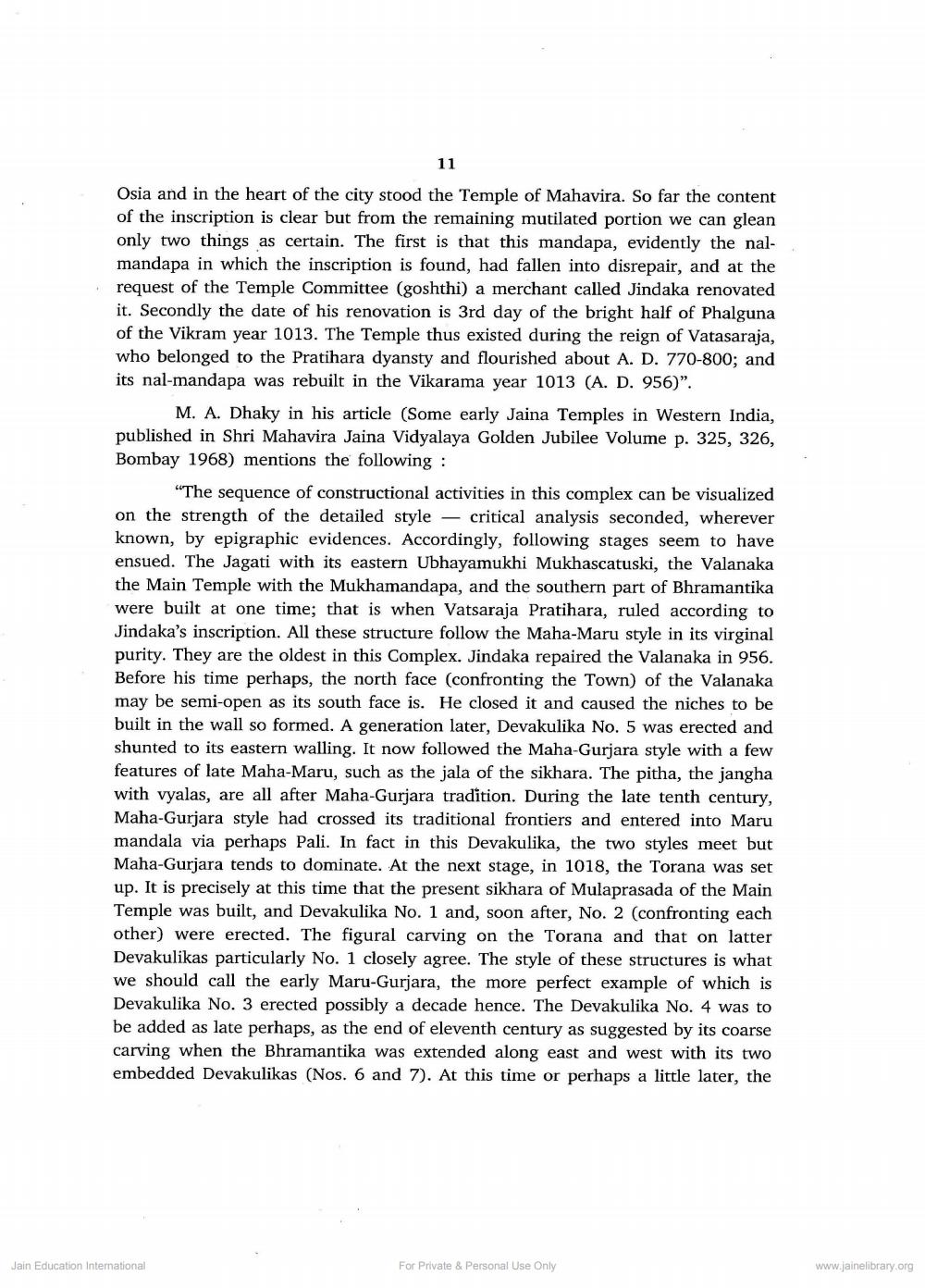________________
11
Osia and in the heart of the city stood the Temple of Mahavira. So far the content of the inscription is clear but from the remaining mutilated portion we can glean only two things as certain. The first is that this mandapa, evidently the nalmandapa in which the inscription is found, had fallen into disrepair, and at the request of the Temple Committee (goshthi) a merchant called Jindaka renovated it. Secondly the date of his renovation is 3rd day of the bright half of Phalguna of the Vikram year 1013. The Temple thus existed during the reign of Vatasaraja, who belonged to the Pratihara dyansty and flourished about A. D. 770-800; and its nal-mandapa was rebuilt in the Vikarama year 1013 (A. D. 956)".
M. A. Dhaky in his article (Some early Jaina Temples in Western India, published in Shri Mahavira Jaina Vidyalaya Golden Jubilee Volume p. 325, 326, Bombay 1968) mentions the following:
"The sequence of constructional activities in this complex can be visualized on the strength of the detailed style critical analysis seconded, wherever known, by epigraphic evidences. Accordingly, following stages seem to have ensued. The Jagati with its eastern Ubhayamukhi Mukhascatuski, the Valanaka the Main Temple with the Mukhamandapa, and the southern part of Bhramantika were built at one time; that is when Vatsaraja Pratihara, ruled according to Jindaka's inscription. All these structure follow the Maha-Maru style in its virginal purity. They are the oldest in this Complex. Jindaka repaired the Valanaka in 956. Before his time perhaps, the north face (confronting the Town) of the Valanaka may be semi-open as its south face is. He closed it and caused the niches to be built in the wall so formed. A generation later, Devakulika No. 5 was erected and shunted to its eastern walling. It now followed the Maha-Gurjara style with a few features of late Maha-Maru, such as the jala of the sikhara. The pitha, the jangha with vyalas, are all after Maha-Gurjara tradition. During the late tenth century, Maha-Gurjara style had crossed its traditional frontiers and entered into Maru mandala via perhaps Pali. In fact in this Devakulika, the two styles meet but Maha-Gurjara tends to dominate. At the next stage, in 1018, the Torana was set up. It is precisely at this time that the present sikhara of Mulaprasada of the Main Temple was built, and Devakulika No. 1 and, soon after, No. 2 (confronting each other) were erected. The figural carving on the Torana and that on latter Devakulikas particularly No. 1 closely agree. The style of these structures is what we should call the early Maru-Gurjara, the more perfect example of which is Devakulika No. 3 erected possibly a decade hence. The Devakulika No. 4 was to be added as late perhaps, as the end of eleventh century as suggested by its coarse carving when the Bhramantika was extended along east and west with its two embedded Devakulikas (Nos. 6 and 7). At this time or perhaps a little later, the
Jain Education International
For Private & Personal Use Only
www.jainelibrary.org




